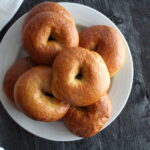Homemade Bagels
Homemade NY-style bagels deliver the perfect balance of a chewy, dense interior and a crisp, golden-brown crust. With this simple recipe, you can recreate the iconic taste and texture of classic bagels right in your own kitchen.
Servings: 12 Bagels
Ingredients
Ingredients for the Dough:
- 2 ¼ cups water lukewarm (105°F–110°F)
- 2 Tbsp barley malt syrup or honey, maple or molasses
- 2 ¼ tsp active dry yeast ¼ ounce, 1 packet
- 6 ½ cups bread flour use bread flour for chewier bagels, but all-purpose will work if that's all you have
- 1 Tbsp salt
- Neutral oil for greasing the baking sheets
For the Boiling Water:
- 1 tsp baking soda
- ¼ cup 60 ml barley malt syrup (or honey, maple or molasses)
Optional Toppings:
- 2 Tbsp Toppings Optional: sesame seeds, poppy seeds, caraway seeds, dried minced garlic, dried minced onion, or flaky salt
Instructions
- Prepare the Yeast Mixture: In a small bowl, combine ½ cup lukewarm water with 2 tablespoons barley malt syrup (or substitute) and yeast. Whisk until the yeast dissolves and let the mixture sit for about 5 minutes, or until it becomes foamy.
- Mix the Dough: In a large bowl, combine the bread flour and salt (and whole-wheat flour, if using). Create a well in the center and pour in the yeast mixture along with the remaining 1 ¾ cups lukewarm water. Use a flexible spatula or wooden spoon to mix everything until the dough begins to come together.
- Knead the Dough: Transfer the dough to a clean surface and begin kneading by hand for about 15-20 minutes. The dough should become smooth, firm, and slightly tacky. Add more flour if necessary to prevent sticking. The key here is to knead thoroughly to develop the gluten, which gives bagels their signature chewy texture.
- First Rise: Once kneaded, shape the dough into a ball, dust it lightly with flour, and place it in a large bowl. Cover it with a damp towel and let it rise at room temperature for 1½ to 2 hours, or until it has doubled in size.
- Pre-shape the Dough: Punch down the dough with your fist to release air, then turn it out onto a clean surface. Using a bench scraper, divide the dough into 12 equal portions (about 4 ⅓ ounces each). For smaller bagels, divide the dough into 13 pieces (about 4 ounces each).Shape each portion into a ball by pulling the edges toward the center and pinching them closed. Then, roll each ball under your hand to form a tight, smooth dome. Let the dough rest for 5 minutes, covered with a damp towel.
- Shape the Bagels: Next, roll each ball into a 9-inch long rope. To form the bagels, wrap the rope around your hand, overlapping the ends by 1-2 inches. Roll the ends together under your hand to seal them into a ring, stretching as necessary to even out the dough. Place each formed bagel on a parchment-lined baking sheet.
- Proof the Bagels: Cover the baking sheets with plastic wrap, followed by a damp towel. Transfer the sheets to the refrigerator and let the bagels proof slowly for 4 hours up to 24 hours. This slow rise helps develop a more complex flavor.
- Preheat the Oven: When you’re ready to bake, preheat your oven to 450°F (230°C).
- Boil the Bagels: Fill a large Dutch oven halfway with water and place it on the stove over high heat. Once the water reaches a boil, whisk in 1 teaspoon baking soda and ¼ cup barley malt syrup (or substitute). You can add more barley malt syrup to achieve a dark, tea-like color. Bring the water back to a boil, skim any foam, and maintain a gentle boil.Take the bagels out of the refrigerator and test one by dropping it into the water. If it floats, the bagels are ready to boil. If not, let the dough sit for a bit longer until the bagels float. Carefully lower the bagels into the boiling water, one at a time, using a slotted spoon or spider. Boil for 1 minute per side. The bagels will puff up in the water but shrink back slightly once removed.
- Top the Bagels: If you want to add toppings, prepare them now. On separate plates, arrange sesame seeds, poppy seeds, or any other desired toppings. After boiling each bagel, immediately dip it into the toppings to coat both sides.
- Bake the Bagels: Place the bagels on a baking sheet, spacing them evenly. Bake for 20–25 minutes, rotating the baking sheet halfway through, until the bagels are deeply golden brown. For an extra-crispy crust, you can spray the bagels with a little water before baking.
- Cool and Slice: Transfer the baked bagels to a wire rack to cool. Allow them to cool completely before slicing with a serrated knife.
Notes
Barley Malt Syrup Substitute: If you can’t find barley malt syrup, don’t worry! You can substitute with molasses, maple syrup, honey, black treacle, or even plain sugar. Each of these will give the bagels a slightly different flavor and texture:
- Molasses: Offers a deeper, richer flavor but will lack the malty undertones of barley malt syrup.
- Maple Syrup: Adds a hint of sweetness and earthiness, though it may slightly soften the texture.
- Honey: Provides a floral sweetness that may slightly affect the chewy texture, but it’s still a great substitute.
- Black Treacle: Similar to molasses, but with a slightly less bitter flavor, adding a darker color to the bagels.
- Plain Sugar: If you just need something neutral, sugar will do the trick, but it won’t have the complex flavor that malt syrup brings.
